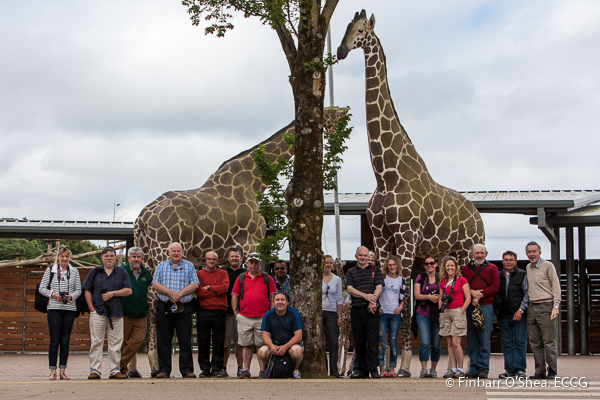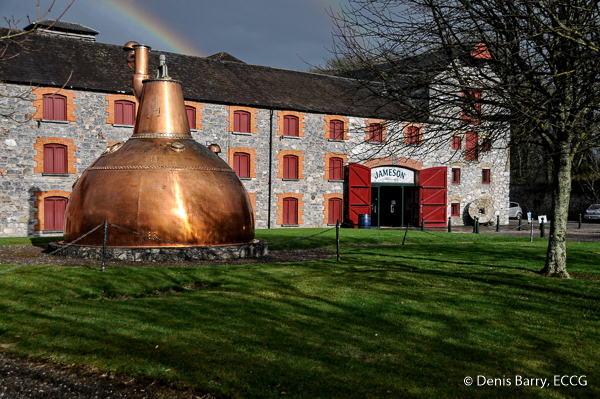
“Far away fields are greener” is an old phrase that describes the human condition of thinking that other places are better than where you are or, that your lot would be better if only you were somewhere else or had something different. It’s an interesting condition that plays out more regularly than we might think whether on a conscious or sub-conscious level, causing us to ignore what’s on our doorsteps in pursuit of ‘something better’ that, often times, just does not exist.
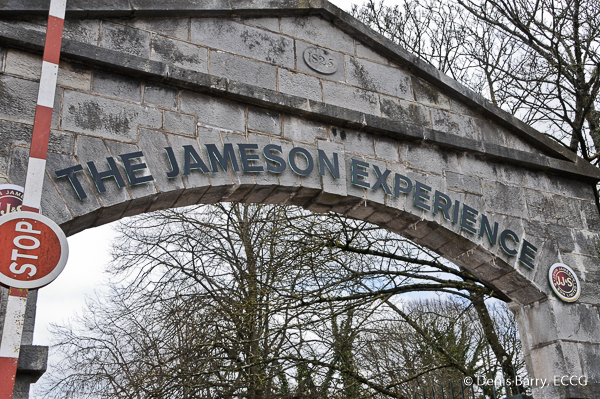 We, in East Cork Camera Group, are as guilty as any other in this department as we criss-cross the county, the province and indeed the country in pursuit of that elusive image which might reside just over the next hill. Well did we get a lesson on the old phrase on Saturday 9/8/14 when we visited The Jameson Experience, right on our doorstep in the middle of the town of Midleton.
We, in East Cork Camera Group, are as guilty as any other in this department as we criss-cross the county, the province and indeed the country in pursuit of that elusive image which might reside just over the next hill. Well did we get a lesson on the old phrase on Saturday 9/8/14 when we visited The Jameson Experience, right on our doorstep in the middle of the town of Midleton.
The Jameson Experience, Midleton is a visitor centre housed in, what was, an actual working distillery that closed in 1975 after 150 years of producing Irish Whiskey, when production moved to the adjoining state-of-the-art facility. Because it is the real thing with real buildings, a giant, working water wheel, the largest copper pot still in the world and extremely knowledgeable guides, the centre practically envelops the visitor in the full whiskey making process from the delivery of the barley on site to the long-term maturation and consumption of the final product.
 Our guide for the visit was Tour Guide Supervisor, Ursula Barry, who wears her passion for the centre on her sleeve, has an extensive knowledge of the site’s history and the whiskey making process and, luckily for us, also has endless patience with lingering photographers trying to exhaust all the angles in every square foot!
Our guide for the visit was Tour Guide Supervisor, Ursula Barry, who wears her passion for the centre on her sleeve, has an extensive knowledge of the site’s history and the whiskey making process and, luckily for us, also has endless patience with lingering photographers trying to exhaust all the angles in every square foot!
As we made our way through the old buildings, we became familiar with processes such as fermentation, mashing, triple distillation and maturation while the origin of the oak casks and the intricacy of the cooper’s trade were fully explained. We learned that the substantial loss of maturing whiskey through natural evaporation is known as ‘The Angels’ Share’ and we also learned that, unlike most beverages, all Jameson whiskeys sold around the world, are manufactured in Midleton. Now that’s a claim to fame, right there!
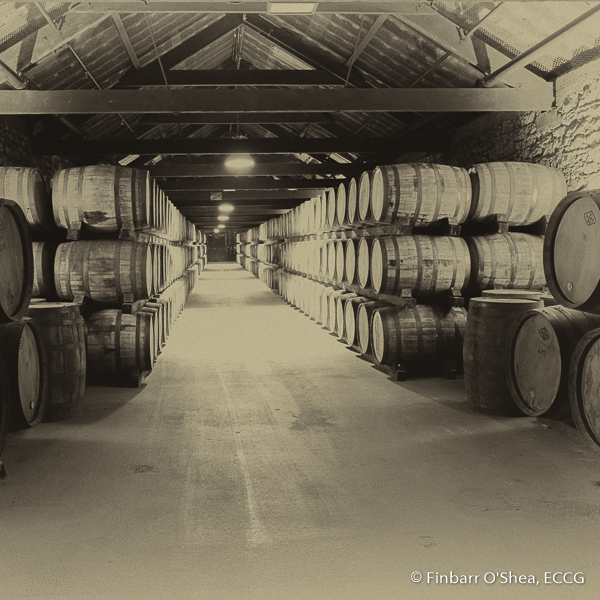 Since being divested of its whiskey making duties in the mid seventies, the site has been primarily used as a visitor centre although it does have one working warehouse, Warehouse A1. This houses around 1,000 casks of whiskey manufactured in the adjoining distillery. The casks will remain in situ to mature for the next twenty years – that’s 2034 – before being bottled for consumption. This is where ‘The Angels’ Share’ story really comes to life as, on opening the doors to the building, the concentrated presence of whiskey vapour in the air is, at once, almost tangible and invades the senses completely, evidencing the special, long-term process that is at hand in the darkness behind the oak.
Since being divested of its whiskey making duties in the mid seventies, the site has been primarily used as a visitor centre although it does have one working warehouse, Warehouse A1. This houses around 1,000 casks of whiskey manufactured in the adjoining distillery. The casks will remain in situ to mature for the next twenty years – that’s 2034 – before being bottled for consumption. This is where ‘The Angels’ Share’ story really comes to life as, on opening the doors to the building, the concentrated presence of whiskey vapour in the air is, at once, almost tangible and invades the senses completely, evidencing the special, long-term process that is at hand in the darkness behind the oak.
The site of The Jameson Experience also houses the Irish Distillers Pernod Ricard Irish Whiskey Academy and the Irish Distillers Pernod Ricard Archive, making Midleton, not alone the center of whiskey making in the country, but also the largest and most complete repository of information regarding whiskey making and the centre of
education for everyone in the whiskey business from manufacturing to sales as well as the many connoisseurs and whiskey collectors around the globe. All in all, a Centre of Excellence for all things whiskey-related.
 As Ursula pointed out, whiskey making has been and continues to be really important to the enconomy of the town of Midleton and the surrounding areas; indeed, one of the distillery’s premium products, ‘Midleton Very Rare‘, carries the towns name into all corners of the globe, a matter of great pride to the locals especially when a bottle is spotted on a shelf by an expat far from home.
As Ursula pointed out, whiskey making has been and continues to be really important to the enconomy of the town of Midleton and the surrounding areas; indeed, one of the distillery’s premium products, ‘Midleton Very Rare‘, carries the towns name into all corners of the globe, a matter of great pride to the locals especially when a bottle is spotted on a shelf by an expat far from home.
The visitor centre then, is the perfect companion for the adjoining ultra-modern distillery and the foresight of those who decided to open it as such was indeed inspired as, upwards of one hundred and twenty thousand visitors, from all over the world, now do the tour there every year while many more just call to enjoy the restaurant facilities in the unique surroundings.
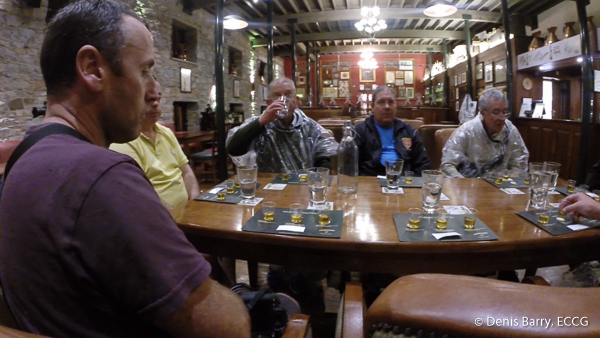
As we finished our tour with the traditional tasting, we were all in agreement that Jameson was the winner from the three samples provided and that ECCG was definitely the winner in our photographic tour of the facility. Our thanks to the management and staff of The Jameson Experience and especially to our tour guide, Ursula, who really brought the tour to life.
As for the old phrase, well whether you’re from the Midleton area or not, the fields are definitely greener here so get yourself here and be sure to pay a visit to The Jameson Experience.
After you watch the short video above, mouse over the images below to activate the slide show controls. Enjoy!
[slideshow_deploy id=’4599′]
[slideshow_deploy id=’5666′]



 Ballycotton was again blessed with a beautiful summer’s day for the annual Ballycotton Lifeboat Open Day on Sunday 3/8/14.
Ballycotton was again blessed with a beautiful summer’s day for the annual Ballycotton Lifeboat Open Day on Sunday 3/8/14.
 In what was one of the most anticipated shoots of the year, ECCG members headed to Portmagee, near Valentia Island, Co. Kerry on Sunday 27/7/14 to catch a boat to Skellig Michael, a rocky island with a
In what was one of the most anticipated shoots of the year, ECCG members headed to Portmagee, near Valentia Island, Co. Kerry on Sunday 27/7/14 to catch a boat to Skellig Michael, a rocky island with a 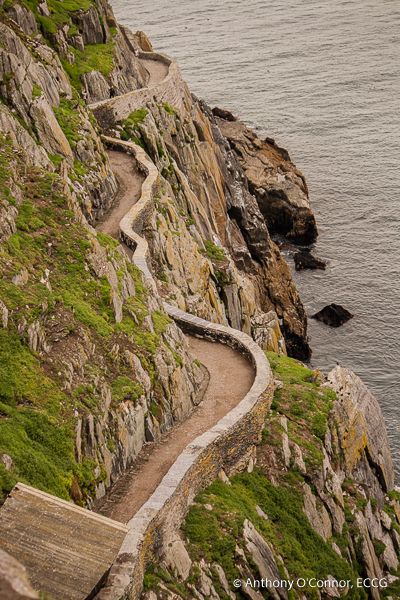 The 50 minute journey to the island, while choppy, quickly allayed the apprehension of some of the land lubbers in the Group and all landed safely at Blind Man’s Cove following some deft maneuvering by the skipper. A 300 meter walk along the lighthouse road, that skirts the south side of the island, gradually rises towards the helicopter pad and about 50 meters further on, is located the beginning of the climb to the top.
The 50 minute journey to the island, while choppy, quickly allayed the apprehension of some of the land lubbers in the Group and all landed safely at Blind Man’s Cove following some deft maneuvering by the skipper. A 300 meter walk along the lighthouse road, that skirts the south side of the island, gradually rises towards the helicopter pad and about 50 meters further on, is located the beginning of the climb to the top. At this point we were taken in charge by one of the resident guides, Cathy (yes they actually reside on the island for 14 days at a time!), who gave us some safety guidelines for our visit. Her advice was perfect as the climb to the top is not for the faint-hearted. There are no two ways about it, it is a dangerous place even on the calm, dry summers day that we experienced. The climb, on dry stone paving, is long and steep and there are very few handrails to grasp. That said, by following the advice of the guides to keep to the paths, go at your own speed, rest when necessary and stop if you feel it’s not for you, the island can be a safe and enjoyable place to be and is really worth a visit. Cathy also explained that the island is a World Heritage Site and underlined the need for visitors to protect and preserve its integrity by taking nothing from or leaving anything on the island.
At this point we were taken in charge by one of the resident guides, Cathy (yes they actually reside on the island for 14 days at a time!), who gave us some safety guidelines for our visit. Her advice was perfect as the climb to the top is not for the faint-hearted. There are no two ways about it, it is a dangerous place even on the calm, dry summers day that we experienced. The climb, on dry stone paving, is long and steep and there are very few handrails to grasp. That said, by following the advice of the guides to keep to the paths, go at your own speed, rest when necessary and stop if you feel it’s not for you, the island can be a safe and enjoyable place to be and is really worth a visit. Cathy also explained that the island is a World Heritage Site and underlined the need for visitors to protect and preserve its integrity by taking nothing from or leaving anything on the island.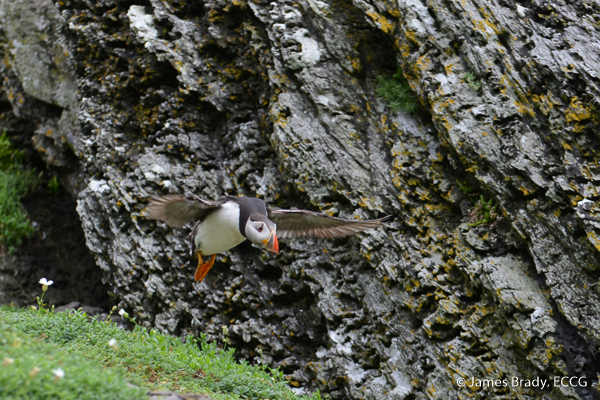 The presence of thousands of puffins, seagulls and other birds who call the island home, for a time at least, is a photo fest indeed and only for the thought that there’s a return boat to be caught a few hours later, a photographer could easily spend the whole day just shooting them as they are really up close and in no way shy.
The presence of thousands of puffins, seagulls and other birds who call the island home, for a time at least, is a photo fest indeed and only for the thought that there’s a return boat to be caught a few hours later, a photographer could easily spend the whole day just shooting them as they are really up close and in no way shy. 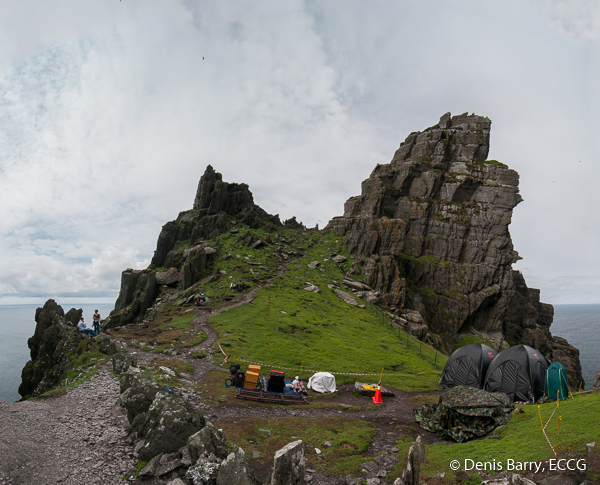
 From Christ’s Saddle another steep flight of steps brings you to the monastic site located on a terraced shelf 600 feet above sea-level, and developed between the sixth and eighth centuries. It contains six beehive cells, two oratories as well as a number of stone crosses and slabs. It also contains a later medieval church. The cells and oratories are all of dry-stone wall construction and a carefully designed system for collecting and purifying water in cisterns was developed. It has been estimated that 12-24 monks and an abbot lived here at any one time. A hermitage is located on the south peak.
From Christ’s Saddle another steep flight of steps brings you to the monastic site located on a terraced shelf 600 feet above sea-level, and developed between the sixth and eighth centuries. It contains six beehive cells, two oratories as well as a number of stone crosses and slabs. It also contains a later medieval church. The cells and oratories are all of dry-stone wall construction and a carefully designed system for collecting and purifying water in cisterns was developed. It has been estimated that 12-24 monks and an abbot lived here at any one time. A hermitage is located on the south peak. 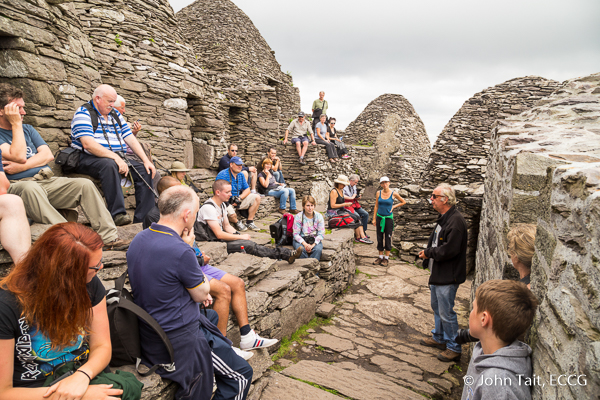 Two lighthouses and living accommodation were built on the island during the 19th century and, as lighthouse keepers were posted to the island for as long as four years at a time, their wives and families moved here also which must have been some experience for them. A second guide, Bob Harris, gave a comprehensive account of the history of the island from the earliest known reference in ancient books right up to the present day.
Two lighthouses and living accommodation were built on the island during the 19th century and, as lighthouse keepers were posted to the island for as long as four years at a time, their wives and families moved here also which must have been some experience for them. A second guide, Bob Harris, gave a comprehensive account of the history of the island from the earliest known reference in ancient books right up to the present day.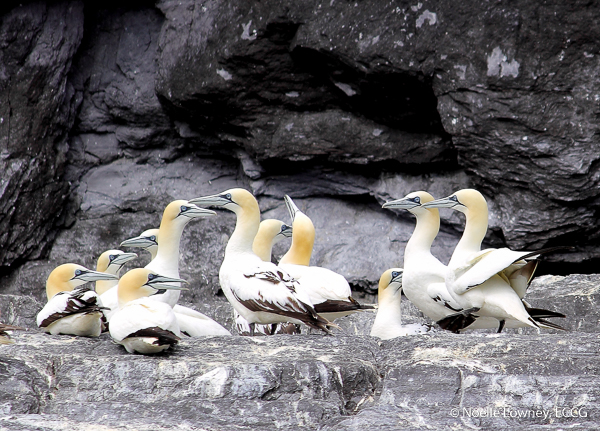 After an hour or so at the summit taking in the breathtaking views and marveling at the incredible engineering abilities and resilience of the monks and the lighthouse keepers that followed them many centuries later, we headed back down the steps to our boat which was waiting at Blind Man’s Cove. On the return trip we paid a close visit to the nearyby
After an hour or so at the summit taking in the breathtaking views and marveling at the incredible engineering abilities and resilience of the monks and the lighthouse keepers that followed them many centuries later, we headed back down the steps to our boat which was waiting at Blind Man’s Cove. On the return trip we paid a close visit to the nearyby 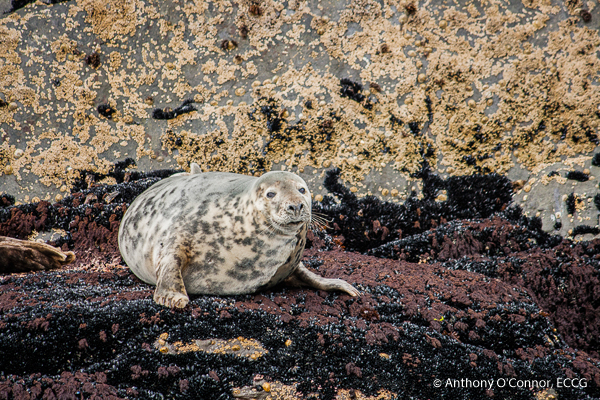 ‘little Skellig’ island which is home to over 23,000 pairs of Gannets, one of the largest colonies in the world. Some seals were also found taking it easy around the island and barely raised their heads as we passed by. The return journey to Portmagee was a bumpy ride to say the least. With a stiff wind and large swell combining, our boat was buffeted quite a bit but we arrived back in port all in one piece and definitely glad we made the trip. What an experience! There was even talk of a return trip….
‘little Skellig’ island which is home to over 23,000 pairs of Gannets, one of the largest colonies in the world. Some seals were also found taking it easy around the island and barely raised their heads as we passed by. The return journey to Portmagee was a bumpy ride to say the least. With a stiff wind and large swell combining, our boat was buffeted quite a bit but we arrived back in port all in one piece and definitely glad we made the trip. What an experience! There was even talk of a return trip….